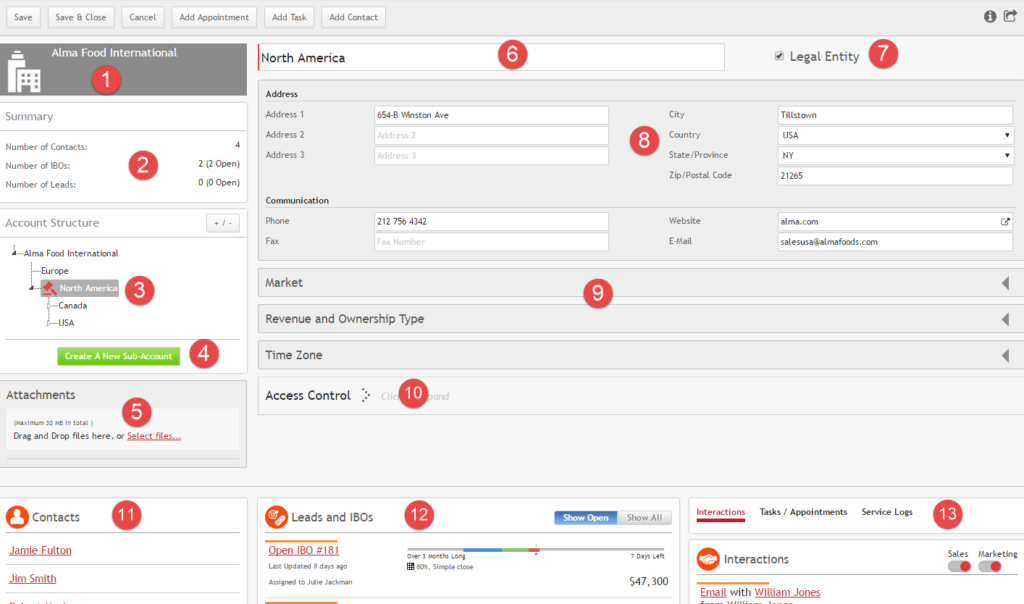Accounts in ASPEC
ASPEC supports a multi-level Account hierarchy.
An Account is a logical grouping of people who work for a common organization and, therefore, have shared interests. Usually an Account is designated by a Sales Manager to be targeted by a sales team with a planned. common sales strategy.
Administering large Accounts can be challenging. Accounts do not have to correspond to the whole complex organization; they can be a smaller part of a big organization. It makes sense to break into conveniently-sized smaller structures, Sub-Accounts. However, you can operate using only a single-level Account Structure if dealing with smaller organizations.
To help you decide how you want to structure your Accounts, please read this post on designing an Account.
Legal Entity is a special Account or Sub-Account. As defined by BusinessDictionary.com, Legal Entity can enter into agreements or contracts, assume obligations, incur and pay debts, sue and be sued in its own right, and to be held responsible for its actions. In ASPEC’s Account Structure they are displayed with this icon: ![]() .
.
Note: To simplify the Online Help, we often refer to Accounts and Sub-Accounts as Accounts.
Account form
The Account form provides a single 360-degree view of an Account, listing related Contacts, IBOs, Interactions, Tasks, Appointments, and more.
The same form is used to display the information related to the root Account at the top, or any Sub-Account, depending on what the user highlights in the Account Structure area.
Fig: Account form
You can find the following information on the Account form:
- Name of the root Account. In the example above Alma Foods International is a root Account for Sub-Account North America
- Summary: Here you can see the number of Contacts, IBOs and Leads associated with the Account or Sub-Account
- Account Structure: Current Account or Sub-Account in the Account Structure: always highlighted. Here you can see where this Sub-Account belongs in the Account tree, its child Sub-accounts as well which Account is its Legal Entity (if any). In the example above, North America’s parent Account is Alma Foods International. Child Accounts (Canada, USA, and lower Sub-Accounts) will use North America in legal proceedings because North America is their closest Legal Entity. Clicking on any node in the Account Structure will load that Sub-Account or Account.
- A green button, visible when Account is edited, for creating a Sub-Account for the Account branch that is currently highlighted
- Attachments
- Account or Sub-Account name. Note that users can click on Account “nodes” in Account Structure (3). After a click, the form loads all the information related to the clicked node. The Account name and the clicked node match.
- A checkbox for marking the Account or Sub-Account as a Legal Entity
- General Account information
- Custom Field sections if configured by the Administrator
- Access Control. Not all users get to see all Sub-Accounts of the Account. Access is managed by granting access to each Sub-Account.
- Contacts widget. Here users see all Contacts linked to the Account or Sub-Account
- Lead and IBOs widget
- Other related records (Interactions, Tasks and Appointments, Service)
Note that the information displayed in widgets rolls up the Account Structure. For example. if you have a Sub-Account Acme East with 2 Contact and Sub-Account Acme West with 3 Contacts, then viewing their parent Account Acme displays all 5 Contacts. Highlighting Acme East in Account Structure displays 2 Contacts and highlighting Acme West displays 3 Contacts.
Creating Accounts
The form for creating a new Account has an additional field for pre-populating Account info based on Google search, provided that Google Places is enabled by your Administrator.
You can create Accounts by clicking the Create button, or by choosing to add a new one while creating other records. Read more on that form here.
Creating Sub-Account
When the Account or Sub-Account is in edit mode, click a green button labeled “Create New Sub-Account”. (You can see this button in the image above). If your parent Account or Sub-Accounts had Contacts underneath, they will be moved under the new Sub-Account that you are creating.
Starting with version 1.19.2, released in August 2018, the order of the Sub-Accounts at the same level can be modified. If you are editing a Sub-Account, you can drag it within the same level. 
Fig: Moving Corporate Headquarters to the top of the list of Your Place Restaurants Inc.
Deleting and Merging Accounts
If you delete an Account, all its Sub-Accounts, Contacts and related records will be deleted as well. Deleting Accounts makes sense when removing a duplicate with no dependant records.
In any other case, we recommend that you merge Accounts.
You will find more on deleting and merging Accounts here
